Engine Compartment EVAP Pipe Removal Procedure
Important: When replacing the evaporative emission (EVAP) pipe, always replace the pipe with original equipment or parts that meet the GM specifications for this part. The replacement pipe must have the same type of fittings as the original pipe in order to ensure the integrity of the connection.
- Clean the pipe connections and the surrounding areas before disconnecting in order to avoid possible contamination of the EVAP system.
- Disconnect the engine compartment EVAP pipe at the EVAP canister purge solenoid.
- Disconnect the engine compartment EVAP pipe (1) at the chassis EVAP pipe (2).
- Remove the EVAP pipe from the engine.
- Cap the EVAP canister purge solenoid and the chassis EVAP pipe in order to prevent possible EVAP system contamination.
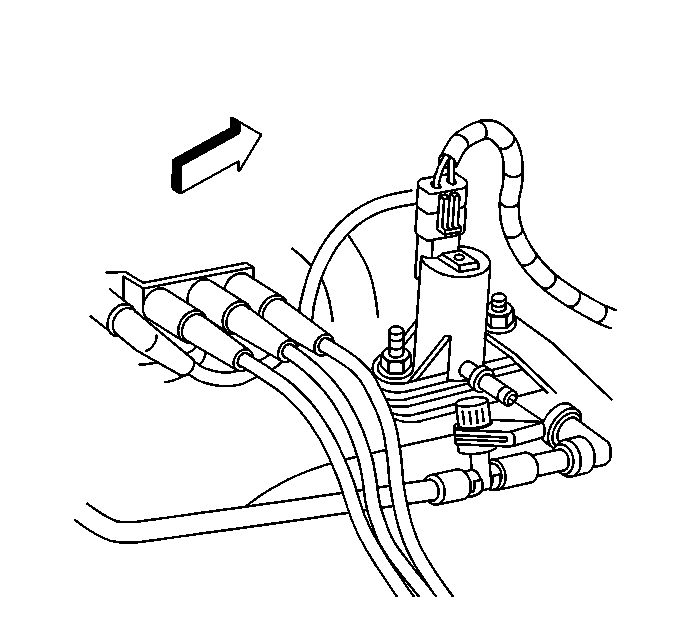
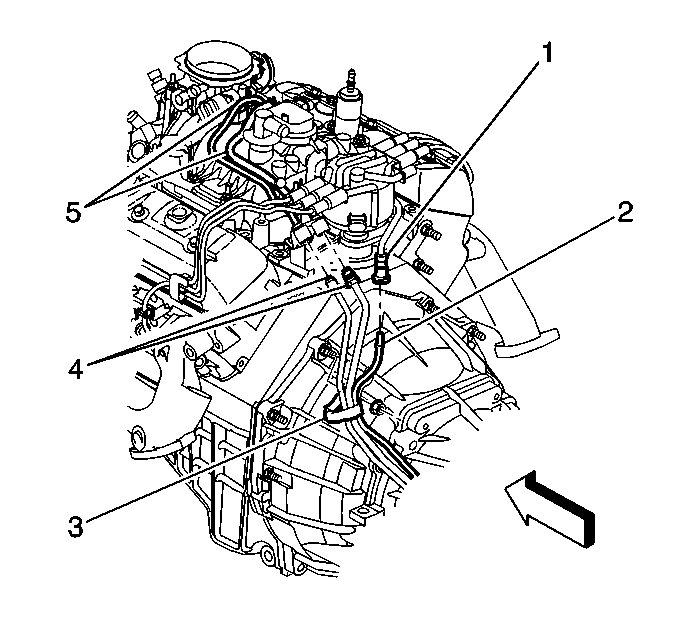
Engine Compartment EVAP Pipe Installation Procedure
- Remove the caps from the EVAP canister purge solenoid and the chassis EVAP pipe.
- Install the EVAP pipe on the engine.
- Connect the engine compartment EVAP pipe (1) to the chassis EVAP pipe (2).
- Connect the engine compartment EVAP pipe at the EVAP canister purge solenoid.


Chassis EVAP Pipe Removal Procedure
Important: When replacing the evaporative emission (EVAP) pipe, always replace the pipe with original equipment or parts that meet the GM specifications for this part. The replacement pipe must have the same type of fittings as the original pipe in order to ensure the integrity of the connection.
- Clean all the EVAP pipe connections and the surrounding areas before disconnecting the pipes in order to avoid possible contamination of the EVAP system.
- Disconnect the engine compartment EVAP pipe (1) from the chassis EVAP pipe (2).
- Cap the engine compartment EVAP pipe.
- Raise the vehicle. Refer to Lifting and Jacking the Vehicle in General Information.
- Remove the EVAP pipe from the bellhousing stud clip (3).
- Remove the EVAP pipe from the transmission bracket clip.
- Remove the EVAP pipe from the transfer case bracket clip, 4 wheel drive only.
- Disconnect the rear EVAP purge pipe (3) from the chassis EVAP purge pipe (2).
- Cap the rear EVAP purge pipe (3).
- Note the position of the EVAP pipe for aid in installation.
- Remove the EVAP pipe from the retaining clips (1).
- Remove the EVAP pipe.

Caution: To avoid any vehicle damage, serious personal injury or death when major components are removed from the vehicle and the vehicle is supported by a hoist, support the vehicle with jack stands at the opposite end from which the components are being removed and strap the vehicle to the hoist.
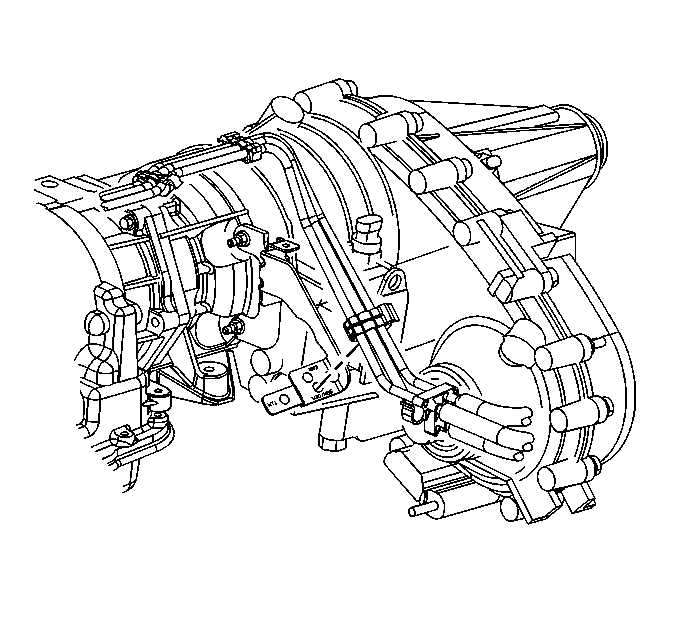

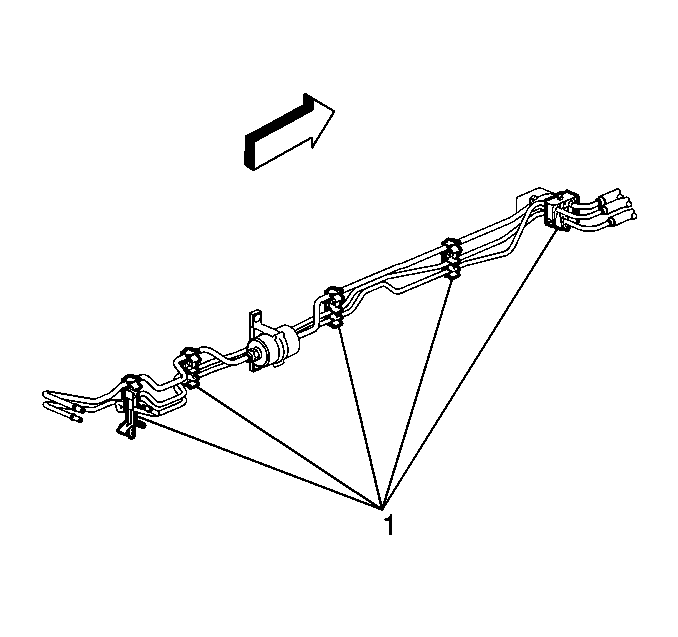
Chassis EVAP Pipe Installation Procedure
- Install the EVAP pipe into the retaining clips (1).
- Remove the cap from the rear EVAP pipe.
- Connect the rear EVAP purge pipe (3) to the chassis EVAP purge pipe (2).
- Install the EVAP pipe into the transfer case bracket clip, 4 wheel drive only.
- Install the EVAP pipe into the transmission bracket clip.
- Install the EVAP pipe into the bellhousing stud clip (3).
- Lower the vehicle.
- Remove the cap from the engine compartment EVAP pipe.
- Connect the engine compartment EVAP pipe (1) to the chassis EVAP pipe (2).




Rear EVAP Purge Pipe Removal Procedure
Important: When replacing the evaporative emission (EVAP) pipe, always replace the pipe with original equipment or parts that meet the GM specifications for this part. The replacement pipe must have the same type of fittings as the original pipe in order to ensure the integrity of the connection.
- Raise the vehicle. Refer to Lifting and Jacking the Vehicle in General Information.
- Clean all the EVAP pipe connections and the surrounding areas before disconnecting in order to avoid possible contamination of the EVAP system.
- Disconnect the rear EVAP purge pipe (3) at the chassis EVAP purge pipe (2).
- Disconnect the rear EVAP purge pipe (3) at the EVAP canister (4).
- Remove the rear EVAP purge pipe (3) from the mounting clip (1).
- Cap the chassis EVAP purge pipe and the EVAP canister in order to prevent possible EVAP system contamination.
Caution: To avoid any vehicle damage, serious personal injury or death when major components are removed from the vehicle and the vehicle is supported by a hoist, support the vehicle with jack stands at the opposite end from which the components are being removed and strap the vehicle to the hoist.

Rear EVAP Purge Pipe Installation Procedure
- Remove the caps from the chassis EVAP purge pipe and the EVAP canister.
- Connect the rear EVAP purge pipe (3) at the EVAP canister (4).
- Connect the rear EVAP purge pipe (3) at the chassis EVAP purge pipe (2).
- Install the rear EVAP purge pipe into the mounting clip (1).
- Lower the vehicle.

EVAP Vent Pipe Removal Procedure
Important: When replacing the evaporative emission (EVAP) pipe, always replace the pipe with original equipment or parts that meet the GM specifications for this part. The replacement pipe must have the same type of fittings as the original pipe in order to ensure the integrity of the connection.
- Disconnect the negative battery cable.
- Relieve the fuel system pressure. Refer to Fuel Pressure Relief .
- Drain the fuel tank. Refer to Fuel Tank Draining .
- Raise the vehicle. Refer to Lifting and Jacking the Vehicle in General Information.
- Clean all fuel and EVAP pipe and hose connections and the surrounding areas before disconnecting in order to avoid possible contamination of the fuel system.
- Remove the fuel tank. Refer to Fuel Tank Replacement .
- Disconnect the EVAP vent pipe (4) at the EVAP vent valve (2).
- Remove the EVAP vent pipe from the mounting clips (1).
- Cap the EVAP vent valve and the EVAP canister in order to prevent possible EVAP system contamination.
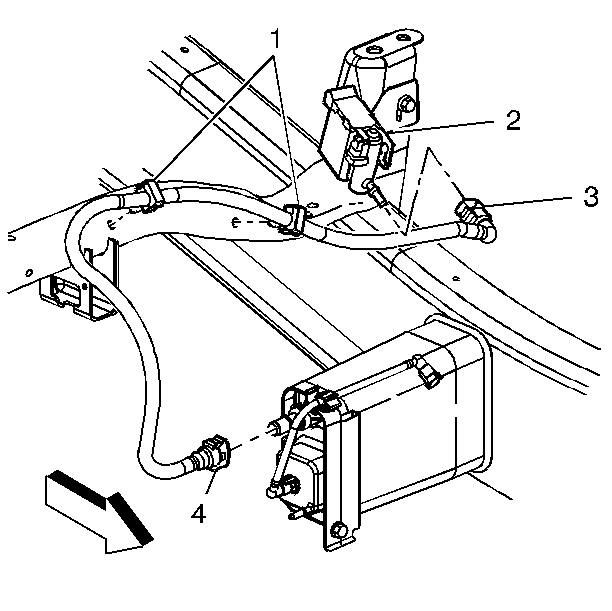
Caution: Unless directed otherwise, the ignition and start switch must be in the OFF or LOCK position, and all electrical loads must be OFF before servicing any electrical component. Disconnect the negative battery cable to prevent an electrical spark should a tool or equipment come in contact with an exposed electrical terminal. Failure to follow these precautions may result in personal injury and/or damage to the vehicle or its components.
Caution: To avoid any vehicle damage, serious personal injury or death when major components are removed from the vehicle and the vehicle is supported by a hoist, support the vehicle with jack stands at the opposite end from which the components are being removed and strap the vehicle to the hoist.
EVAP Vent Pipe Installation Procedure
- Remove the caps from the EVAP vent valve and the EVAP canister.
- Connect the EVAP vent pipe (4) to the EVAP vent valve (2).
- Install the EVAP vent pipe into the mounting clips (1).
- Install the fuel tank. Refer to Fuel Tank Replacement .
- Lower the vehicle.
- Refill the fuel tank.
- Connect the negative battery cable.
- Tighten the fuel filler cap.
- Inspect for leaks.

| 9.1. | Turn the ignition ON for 2 seconds. |
| 9.2. | Turn the ignition OFF for 10 seconds. |
| 9.3. | Turn the ignition ON. |
| 9.4. | Inspect for fuel leaks. |
Rear EVAP Fuel Tank Pipe Removal Procedure
Important: When replacing the evaporative emission (EVAP) pipe, always replace the pipe with original equipment or parts that meet the GM specifications for this part. The replacement pipe must have the same type of fittings as the original pipe in order to ensure the integrity of the connection.
- Disconnect the negative battery cable.
- Relieve the fuel system pressure. Refer to the Fuel Pressure Relief .
- Drain the fuel tank. Refer to Fuel Tank Draining .
- Raise the vehicle. Refer to Lifting and Jacking the Vehicle in General Information.
- Clean all fuel and EVAP pipe and hose connections and the surrounding areas before disconnecting in order to avoid possible contamination of the fuel system.
- Remove the fuel tank. Refer to Fuel Tank Replacement .
- Remove the rear EVAP pipe (1) from the fuel sender (2), the fuel tank roll over valve (3), and the fuel tank clips (6).
- Cap the fuel sender EVAP pipe and the fuel tank roll over valve.
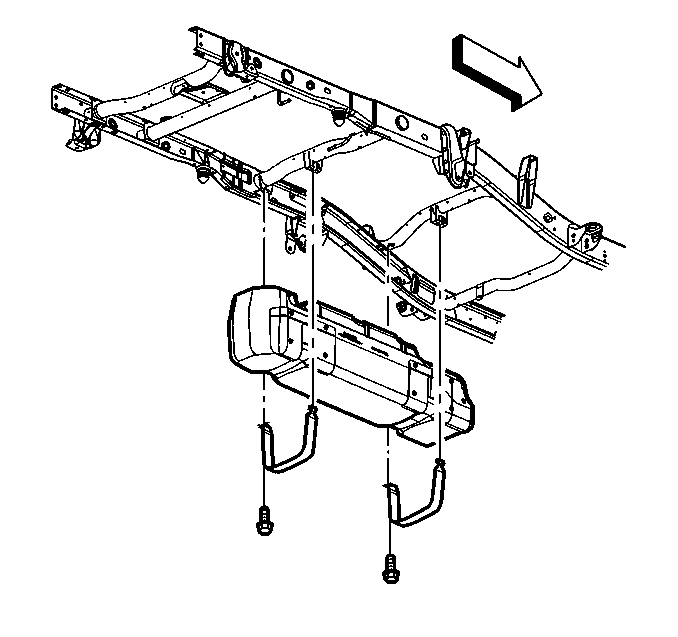
Caution: Unless directed otherwise, the ignition and start switch must be in the OFF or LOCK position, and all electrical loads must be OFF before servicing any electrical component. Disconnect the negative battery cable to prevent an electrical spark should a tool or equipment come in contact with an exposed electrical terminal. Failure to follow these precautions may result in personal injury and/or damage to the vehicle or its components.
Caution: To avoid any vehicle damage, serious personal injury or death when major components are removed from the vehicle and the vehicle is supported by a hoist, support the vehicle with jack stands at the opposite end from which the components are being removed and strap the vehicle to the hoist.
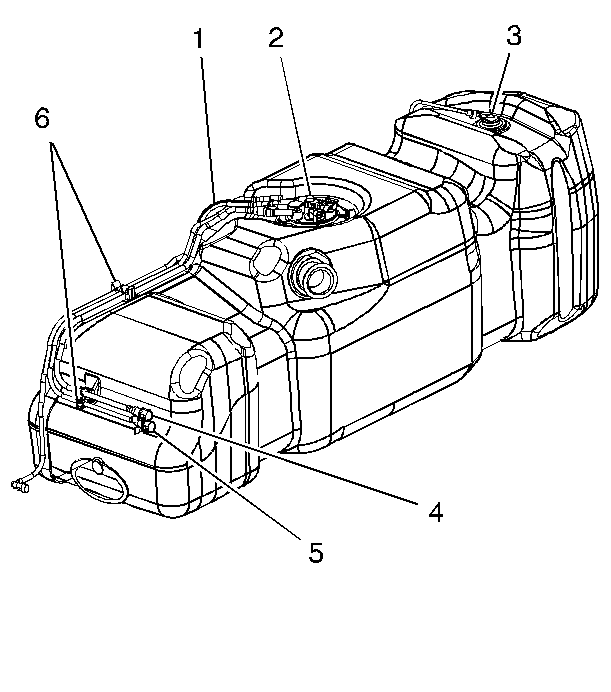
Rear EVAP Fuel Tank Pipe Installation Procedure
- Remove the caps from the fuel sender EVAP pipe and the fuel tank roll over valve.
- Connect the rear EVAP pipe (1) to the fuel sender (2), the fuel tank roll over valve (3), and the fuel tank clips (6).
- Install the fuel tank. Refer to Fuel Tank Replacement .
- Lower the vehicle.
- Refill the fuel tank.
- Connect the negative battery cable.
- Tighten the fuel filler cap.
- Inspect for leaks.


| 8.1. | Turn the ignition ON for 2 seconds. |
| 8.2. | Turn the ignition OFF for 10 seconds. |
| 8.3. | Turn the ignition ON. |
| 8.4. | Inspect for fuel leaks. |
